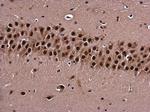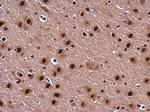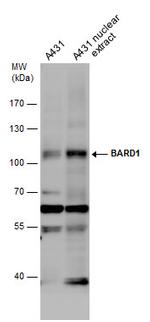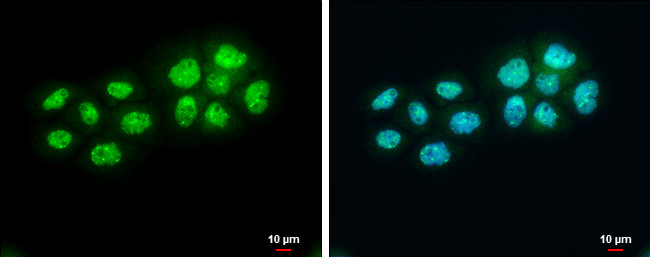Search Thermo Fisher Scientific
FIGURE: 1 / 9
BARD1 Antibody (PA5-85707) in ICC/IF









Product Details
PA5-85707
Species Reactivity
Host/Isotype
Class
Type
Immunogen
Conjugate
Form
Concentration
Purification
Storage buffer
Contains
Storage conditions
Shipping conditions
RRID
Product Specific Information
Keep as concentrated solution.
Positive Control: A431, A431 nuclear extract.
Store product as a concentrated solution. Centrifuge briefly prior to opening the vial.
Target Information
This gene encodes a protein which interacts with the N-terminal region of BRCA1. In addition to its ability to bind BRCA1 in vivo and in vitro, it shares homology with the 2 most conserved regions of BRCA1: the N-terminal RING motif and the C-terminal BRCT domain. The RING motif is a cysteine-rich sequence found in a variety of proteins that regulate cell growth, including the products of tumor suppressor genes and dominant protooncogenes. This protein also contains 3 tandem ankyrin repeats. The BARD1/BRCA1 interaction is disrupted by tumorigenic amino acid substitutions in BRCA1, implying that the formation of a stable complex between these proteins may be an essential aspect of BRCA1 tumor suppression. This protein may be the target of oncogenic mutations in breast or ovarian cancer.
For Research Use Only. Not for use in diagnostic procedures. Not for resale without express authorization.
References (0)
Bioinformatics
Protein Aliases: BARD 1; BARD-1; BRCA1-associated RING domain gene 1; BRCA1-associated RING domain protein 1; RING-type E3 ubiquitin transferase BARD1
Gene Aliases: BARD1; ENSMUSG00000060893; ENSMUSG00000073653
UniProt ID: (Human) Q99728, (Mouse) O70445, (Rat) Q9QZH2
Entrez Gene ID: (Human) 580, (Mouse) 12021, (Rat) 64557

Performance Guarantee
If an Invitrogen™ antibody doesn't perform as described on our website or datasheet,we'll replace the product at no cost to you, or provide you with a credit for a future purchase.*
Learn more
We're here to help
Get expert recommendations for common problems or connect directly with an on staff expert for technical assistance related to applications, equipment and general product use.
Contact tech support
